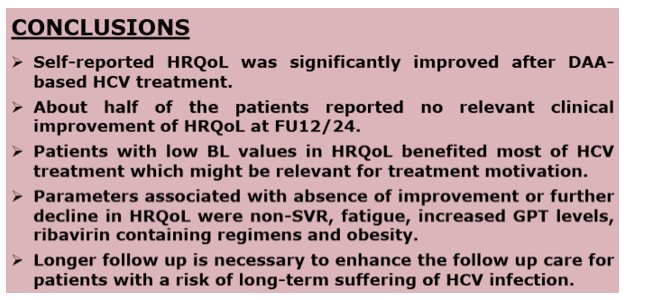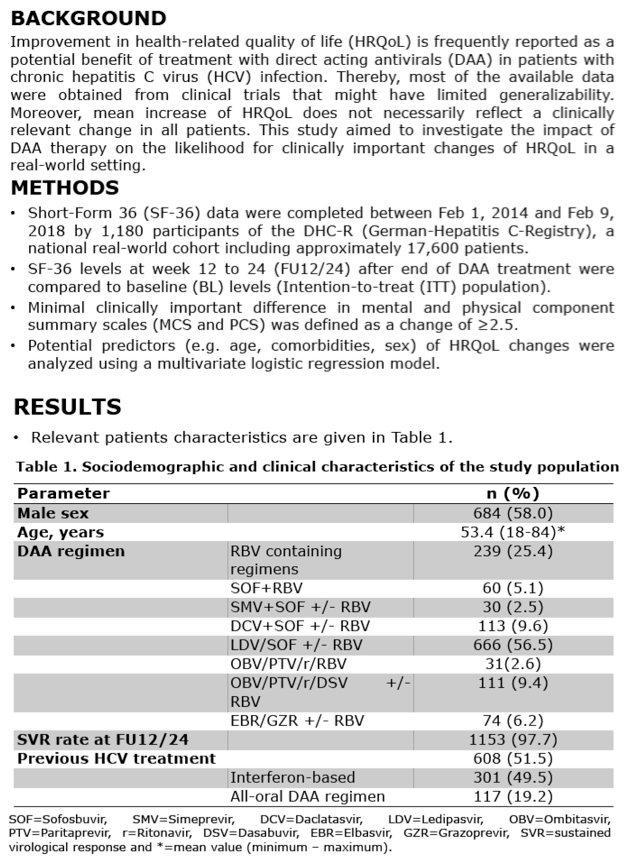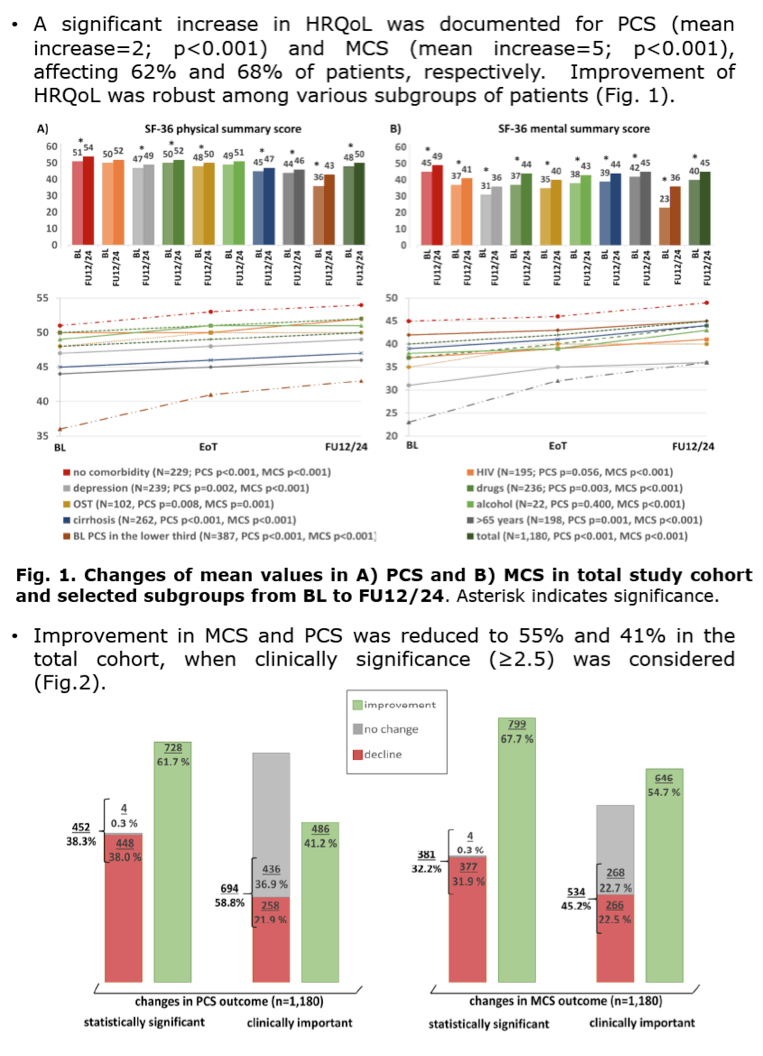 |
 |
 |
| |
Clinically important changes in health-related quality of life after treatment of chronic hepatitis C virus infection with direct acting antivirals in a large real-world setting- results from the German Hepatitis C-Registry (DHC-R)
|
| |
| |
AASLD 2020 Nov 11-16 virtual
Reported by Jules Levin
Valerie Ohlendorf1 Arne Schafer2, Stefan Christensen3, Renate Heyne4, Uwe Naumann5, Ralph Link6, Christoph Herold7, Willibold Schiffelholz8, Rainer Günther9, Markus Cornberg1, Yvonne Serfert10, Benjamin Maasoumy1, Heiner Wedemeyer10,1, Michael R. Kraus11, German Hepatitis C-Registry10 1Hannover Medical School, Hannover, Germany; 2Diabetes-Klinik Bad Mergentheim, Bad Mergentheim, Germany; 3CIM Münster, Münster, Germany; 4Leberzentrum am Checkpoint, Berlin, Germany; 5UBN/Praxis, Berlin, Germany; 6MVZ-Offenburg GmbH /St. Josefs-Klinik, Offenburg, Germany; 7Internisten am Ring, Nürnberg, Germany; 8Gastroenterologische Schwerpunktpraxis, Augsburg, Germany; 9Universitatsklinikum Schleswig-Holstein (UKSH), Campus Kiel, Department of Internal Medicine I, Kiel, Germany; 10Leberstiftungs-GmbH Deutschland, Hannover, Germany; 11Kreiskliniken Altötting-Burghausen, Burghausen, Germany

abstract
Background: Improvement in health-related quality of life (HRQoL) is frequently reported as a potential benefit of treatment with direct acting antivirals (DAA) in patients with chronic hepatitis C virus (HCV) infection . Thereby, most of the available data were obtained from clinical trials that might have limited generalizability . Moreover, median increase of HRQoL does not necessarily reflect a clinical relevant change in all patients . This study aimed to investigate the impact of DAA therapy on the likelihood for clinically important improvements of HRQoL in a real-world setting.
Methods: Short-Form 36 (SF-36) data were completed between Feb 1, 2014 and Feb 9, 2018 by participants of the DHC-R (German- Hepatitis C-Registry), a national real-world cohort of over 15,500 HCV infected patients . SF-36 levels at week 12 to 24 (FU12/24) after end of treatment were compared to baseline (BL) levels . Minimal clinically important difference in mental and physical component summary scales (MCS and PCS) was defined as an increase of ≥2.5. Potential predictors (e.g. age, comorbidities, sex) of HRQoL changes were analyzed using a multivariate linear regression model .
Results: A total of 1,180 patients were analyzed, of whom 1,153 (97 .7%) achieved sustained virological response after DAA therapy . Overall, a statistically significant increase in HRQoL was documented for PCS (mean increase=2; p<0 .001) and MCS (mean increase=5; p<0 .001) affecting 62% and 68% of patients, respectively . This improvement was robust among various subgroups of patients including those with active drug usage as well as opioid substitution therapy . However, 59% and 43% of all patients failed to achieve a clinically important improvement (≥2.5) in MCS and PCS. Patients with lower MCS and PCS levels at BL had the highest chances for a clinically important increase in MCS (p=0 .022) and PCS (p<0 .001) after DAA therapy . Within the subgroup of low MCS scores at BL a BMI >30 kg/m2 (p=0 .034) and no SVR (p=0 .005) were identified as independent risk factors for failing to gain a clinically important increase of MCS. Age ≥65years (p=0.001) and depression (p=0 .010) were associated with no clinically important improvement of PCS.
Conclusion: DAA treatment is associated with an improvement of HRQoL in patients with chronic HCV infection . Patients with low MCS or PCS baseline values benefit most from DAA treatment. Nevertheless, roughly half of the patients fail to achieve a clinically important improvement . Figure: Proportion of patients with changes in SF-36 MCS and PCS at FU12/24 after DAA therapy .



|
| |
|
 |
 |
|
|